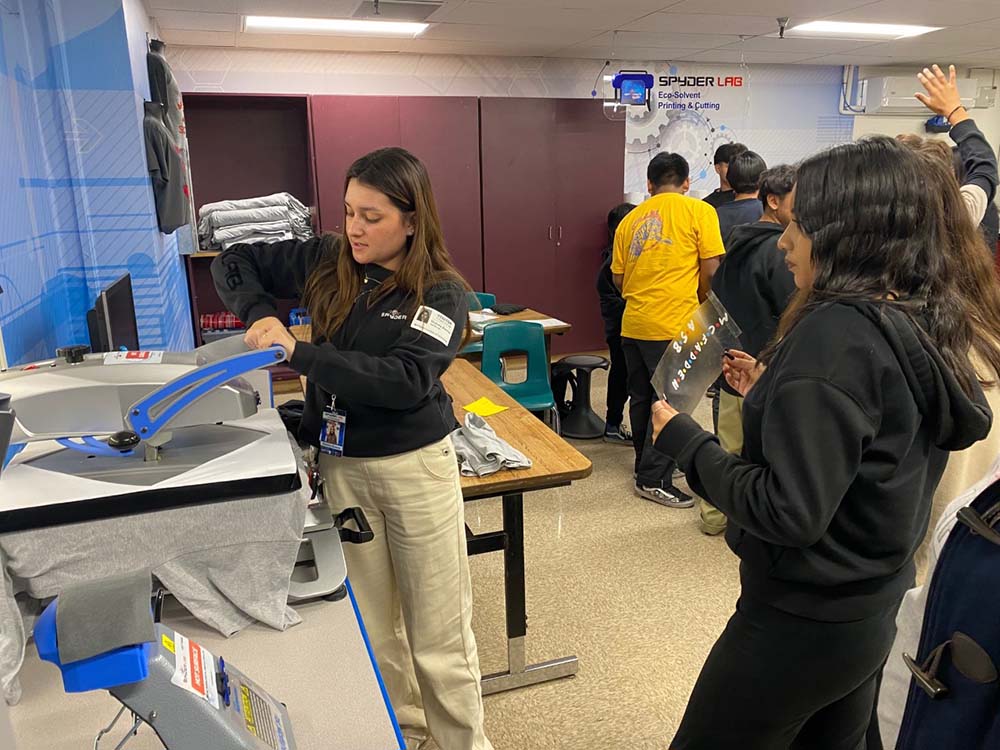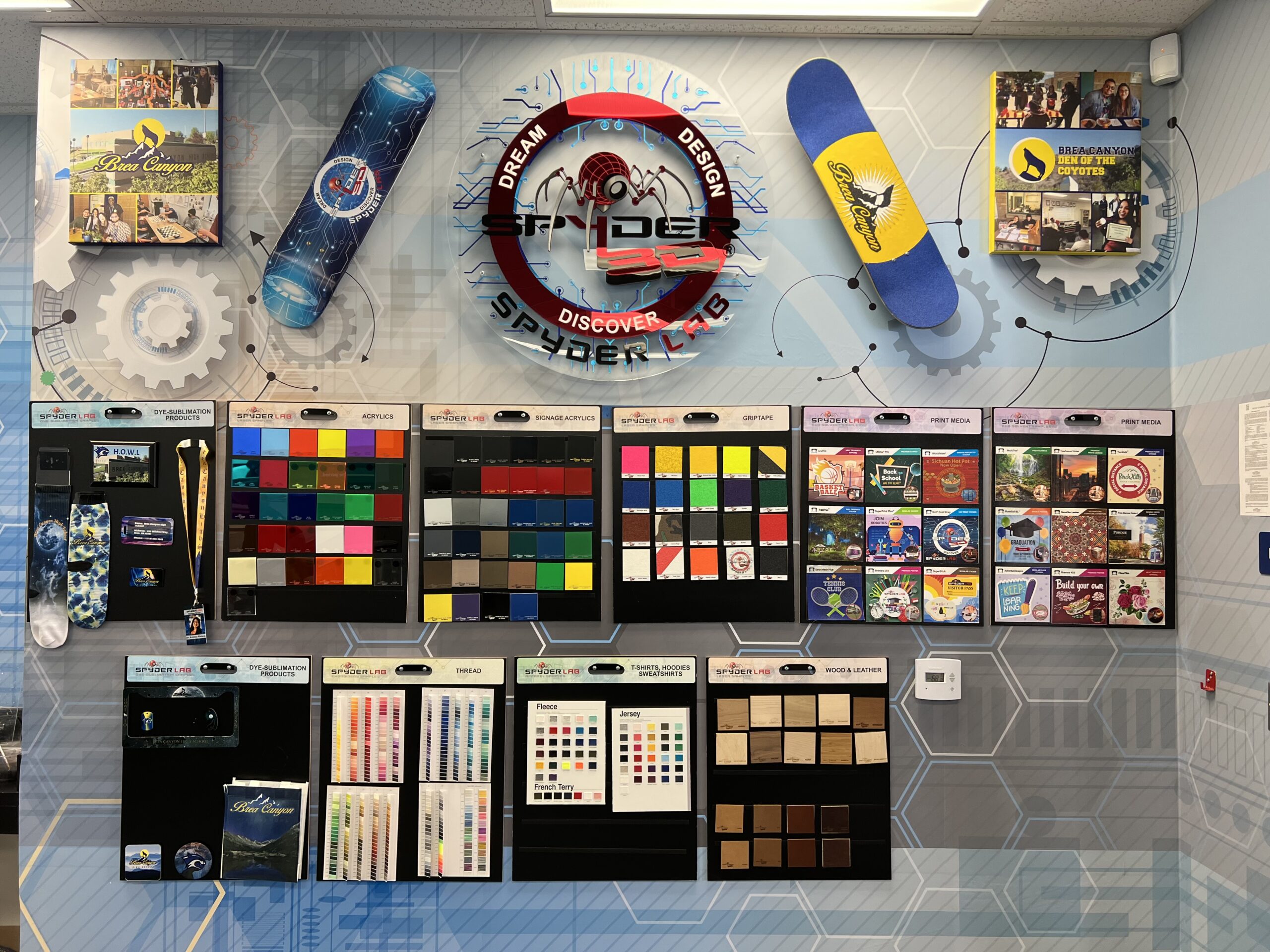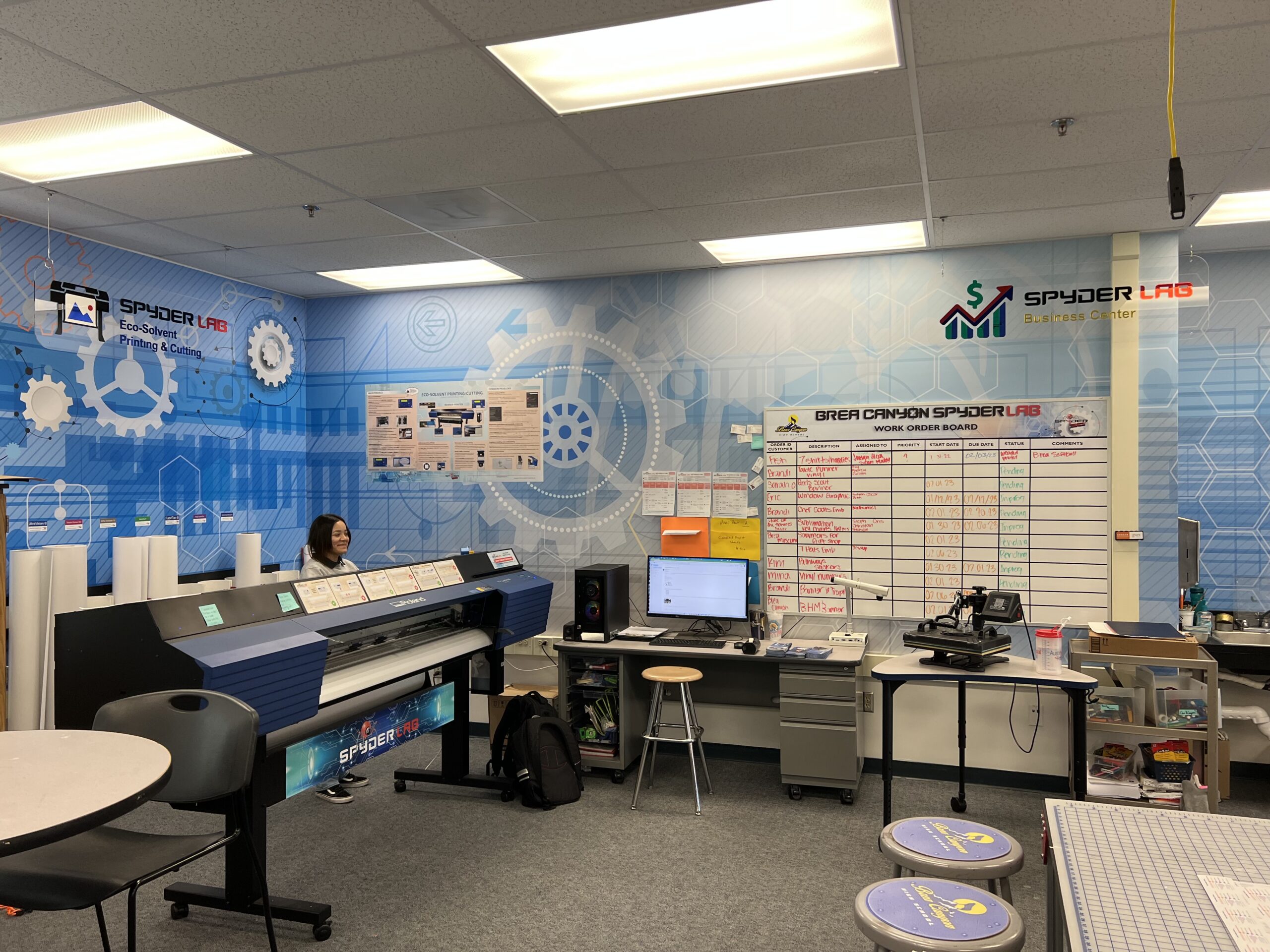How Spyder Lab Preps High School Students for the Printing Workforce
Spyder Lab Founder Joe Bloomfield creates pathways for students looking to explore their creative side

Work-based school program Spyder Lab brings printing and workforce training to schools across the greater Los Angeles, California area, fostering the next generation of print leaders and graphics entrepreneurs.
The program takes a unique approach. Rather than just be a makerspace, Spyder Lab allows students to run a graphic media business right on campus. The students take on general manager roles and work in production and sales. It’s a full-fledged print shop, bringing any school printing needs in-house. Additionally, the program allows students to create products of their own — all while earning high school credit.
From direct-to-garment, dye-sublimation, and white toner transfer printing to laser engraving, large-format, and 3D printing, students learn a breadth of skills to prepare them for the workforce — whether that’s being hired on at an established print business or starting one of their own. The students also learn soft skills like critical thinking, conflict resolution, communication, and collaboration.
Joe Bloomfield, the founder of Spyder Lab, says the program launched about six years ago when he started mentoring students at his daughter’s high school and realized there was a need for some type of career-prep program. Today, Spyder Lab is in 18 schools, with eight more labs launching soon. In addition to high schools, Spyder Lab can also be found in middle and continuation schools and some colleges, plus one Anaheim elementary.
Bloomfield says not all students plan to go to college or have enough money for secondary or trade education. “We’re finding out that a lot of the creatives, and really good creatives tend to lack in the academic side,” he adds, so he wanted to create a space where they could learn skills for a career outside of high school. While many schools tout programs that prepare students for the workforce, he says there aren’t programs that truly get students career ready. Upon finishing the Spyder Lab program, students not only have print experience but knowledge of how to deal with a customer, profit margins, and the cost of goods sold.
Print businesses need the next generation of employees who already know the trade, Bloomfield argues. “Are you going to train them, or would you rather have a student that’s already taken this for two to four years?” he poses. Early education is what he says the industry previously lacked. “There was a big gap between educators and business. There was no collaboration between the two.” He aims to bridge the gap — knowing what an employer needs and how an employee can fill that need.
While a business could spend tens of thousands of dollars training someone new, there's the possibility they could quit at any time. That business could then be out upwards of $10,000, says Bloomfield. Instead, they could hire skilled staff who understand the equipment, industry, and project management, plus have interpersonal skills in a print setting.

How the Program Works
While the curriculum includes learning print and management skills, students never actually take any written tests. They’re tested on their knowledge through product creation and project management, and before any student can use the equipment on their own, they must get badged or certified to do so.
Spyder Lab is offered two days per week for three hours at a time, with some schools providing it five days per week. Two Spyder Lab instructors come into the school for “industry-led lab time,” explains Bloomfield, while a school teacher helps facilitate. The program runs as a career and technical education program, also known as CTE.
Spyder Lab at Back Bay High School in Costa Mesa, California. Equipment at this location includes a Spyder Nest 3D printer, Roland SG3-540 printer/cutter Ricoh Ri 1000 DTG printer, Epilog Fusion Pro 36, Roland GS-24 vinyl cutter, Hotronix Fusion IQ heat press, Hotronix 360 IQ hat press, Sawgrass SG1000 dye-sublimation printer.
Every student gets a digital employment portfolio that showcases their work, which they can submit to potential employers for review. It features video snippets of their technical skills and five interview-style questions and answers about their soft skills. And while many students end up employed with a print business or starting one of their own, Bloomfield says some students become Spyder Lab teachers the year following graduation. Through the program, students receive mentoring and can see a climbable ladder and career possibilities from beginning to end.
Talking about hiring, Bloomfield tells print shops they don’t need someone out of college. “There’s some really good talent out there that you’re missing out on,” he stresses. “What you need is qualified employees that are young, willing to stay with you, willing to grow with the company.”
Asking about the breakdown of career paths of graduating students, Bloomfield says about half become print entrepreneurs, using their design, business, and print knowledge to make and sell custom products. The other half is split between being hired by Spyder Lab to teach the next generation of students and being hired by local print companies.
To help get students in front of hiring managers, Spyder Lab has relationships with various chambers of commerce to ensure businesses know about for-hire talent. However, this year, Spyder Lab will host its first job fair where employers can come into the lab and visit with recent program graduates.
At the time of writing, between each location, Bloomfield says about 250-300 students are currently enrolled in the program with room for expansion and growth.

Collaboration and Convergence
Speaking to how Bloomfield has managed such rapid growth in six years, he says it all comes down to people and collaboration — intertwining education with business. He makes special mention of the Orange County Department of Education for its support and help with writing the curriculum for the program.
Looking ahead, Spyder Lab is working on launching in more schools, as well as building an e-commerce site exclusively for students to post their designs and start earning money while still in school. Through this, Bloomfield hopes to show students they can make a living from their creative side and help parents embrace and understand their children’s creative abilities. He argues that parental support goes a long way toward a child’s success in following their passion.
For businesses looking at expanding their offerings and adding new print processes, hiring people with a range of skills in various types of equipment is key to growth, says Bloomfield. This is where convergence enters the conversation — blending and incorporating several elements or print processes to make one cohesive yet diverse offering. Businesses that solely focus on printed apparel are now looking at entering new spaces like promotional products, signage, and other revenue-generating processes.
“By hiring one of our graduates out of the program, you’re going to get your profit margins up because you’re going to start getting into areas that you weren’t,” Bloomfield argues. “You’ve got to be diversified in your product offering.”
Aside from expanding into more schools, Bloomfield says he’s eyeing UV printing. Outside of the printing world, he’s working to identify employers’ needs and learning opportunities. Right now, that’s experimenting with virtual and augmented-reality spaces and figuring out ways to work that into the program. Spyder Lab also recently partnered with Santa Ana College for students that want to further their skills and learn more beyond high school.
For Bloomfield, Spyder Lab is driven by a passion for giving students a pathway to success no matter their circumstances.



